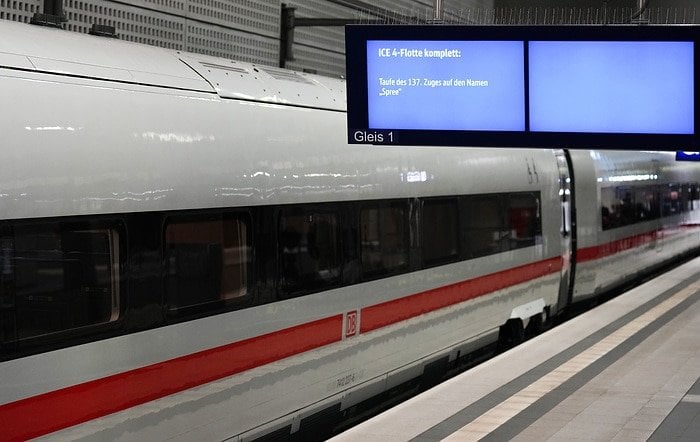railway-international.com
20
'24
Written on Modified on
Billion-euro project completed on time: ICE 4 fleet now complete
137th ICE 4 christened “Spree” at the Berlin Central Station.

With the delivery of the 137th train, the ICE 4 fleet of Deutsche Bahn (DB) is now complete. The punctually delivered train was christened “Spree” in Berlin today. Richard Lutz, CEO of DB, Volker Wissing, Federal Minister for Digital Affairs and Transport, Manja Schreiner, Senator for Mobility, Transport, Climate Protection and the Environment in Berlin, Michael Peterson, DB Member of the Management Board for Long Distance Passenger Transport, and Roland Busch, CEO of Siemens AG, took part in the official naming ceremony at the Berlin Central Station. The 7-car ICE 4 was christened with water from the Spree River in Berlin. Manufacturer Siemens Mobility has delivered 137 ICE 4 trains in three different variants since 2016 – totaling over 1,500 cars with around 105,000 seats. Today’s ceremony marked the completion of the largest procurement program in DB’s history.
Richard Lutz, CEO of Deutsche Bahn AG: “Siemens and DB have delivered this project right on time. Expansion of the DB fleet is a central lever for achieving the goal of our Strong Rail strategy: doubling the number of travelers using our long-distance rail services. Because those who travel by train help protect the climate. We invested six billion euros in the 137 ICE 4 trains alone. And we will continue putting a new ICE train in service for our passengers every three weeks in 2024.”
Volker Wissing, Federal Minister for Digital Affairs and Transport: "People in our country rightly expect reliable and punctual trains again as soon as possible. Modernizing the fleet is a key element in minimizing disruptions. By 2030, around 12 billion euros will therefore be invested in new long-distance trains, the ICE fleet will grow to 450 ICE trains and the average age of ICE and Intercity trains will fall from 18 to 12 years. In combination with the general refurbishment of the network, all the signs point to improvement."
Manja Schreiner, Senator for Mobility, Transport, Climate Protection and the Environment in Berlin: "Modern, contemporary trains are important for the attractiveness of rail transport in the Berlin-Brandenburg metropolitan region. If the decarbonization of the transport sector were a card game, then the ICE 4, whose fleet has a total of 105,000 seats, could be described as the ace of trumps."
Roland Busch, CEO of Siemens AG: “The punctual delivery of the last ICE 4 marks a great joint success for Deutsche Bahn and Siemens. As the longest train in the ICE fleet, the ICE 4 has around 25% more seats. And since it is lighter and more aerodynamic, it uses 30% less energy than previous models. Over its lifetime, each train replaces 20,000 cars and saves up to 400,000 tons of CO2. Every ICE in service is good for the climate, for mobility, and for Germany’s position as a location for industry and business. My special thanks go to the teams at DB, Siemens, and our partners for this great achievement.”
All in all, DB received a total of 137 ICE 4 trains in different variants. In addition to the 37 7-car trains, there are 50 12-car trains as well as 50 13-car XXL ICE trains in service. The latter offer seating for nearly 1,000 passengers – more than ever before in an ICE and five times more than in medium-haul aircraft. These long trains run on routes that are particularly in demand, such as from Hamburg via North Rhine-Westphalia and via the Rhine/Main high-speed line to southern Germany. Like the other 7-car trains, the ICE “Spree” will primarily operate between Berlin and North Rhine-Westphalia as well as between Frankfurt am Main, Munich, Salzburg, and Klagenfurt.
DB now has the most modern and, with over 400 trains, the largest ICE fleet of all time. DB will also be taking delivery of another ICE train every three weeks in 2024. By heavily investing in the modernization of its fleet and the purchase of new trains, DB is continuing to drive its strategy for ensuring a strong rail system in Germany. DB initiated this strategy in 2019 and has consistently implemented it ever since – despite facing adverse circumstances such as the COVID-19 pandemic, the war in Ukraine, and the energy crisis – with the clear goal of achieving the German government’s transport sector targets.
www.mobility.siemens.com

